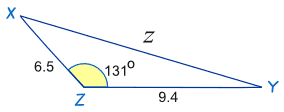As posted in Wikipedia, " in Trigonometry, the law of cosines (also known as the cosine formula, cosine rule, or al-Kashi's theorem) relates the lengths of the sides of a triangle to the cosine of one of its angles.
Sa paskel sa Wikipedia, "sa Trigonometry, ang batas ng cosines (kilala rin bilang formula ng cosine, panuntunan sa cosine, o theorem ng al-Kashi) ay nauugnay ang haba ng mga gilid ng isang tatsulok sa cosine (adjacent side/hypotenuse) ng isa sa mga anggulo nito.
The law of cosines states: (Ipinapahayag ng batas ng cosines na:)
c2 = a2 + b2 − 2ab cos(C)
kung saan ang C ay ang anggulo na nilalaman sa pagitan ng mga gilid ng haba a at b at sa tapat ng gilid ng haba c.
The law of cosines generalizes the Pythagorean theorem, which holds only for right triangles: if the angle C is a right angle (of measure 90 degrees, or π/2 radians), then cos C = 0, and thus the law of cosines reduces to the Pythagorean theorem: (Binuod ng batas ng mga cosines ang Pythagorean theorem, na tumpak lamang para sa mga right angles: kung ang anggulo C ay isang right angle (may sukat na 90 degree, o π / 2 radians), ang cos C = 0, at sa gayon ang batas ng cosines ay nagiging sa teorama ng Pythagorean:)
c2 = a2 + b2
Ang Cosine Rule ay maaari ring isulat na:
a2 = b2 + c2 − 2bc cos(A)
b2 = a2 + c2 − 2ac cos(B)
Tingnan ang pigura sa ibaba upang maunawaan.
Sa halip na a2 = b2 + c2 − 2bc cos(A),
maaari nating gamitin ang==>
z2 = x2 + y2 − 2xy cos(Z)
Ilagay ang mga value o sukat na alam na natin:
Angle Z = 131º
x = 9.4
y = 6.5
z2 = 9.42 + 6.52 − 2×9.4×6.5×cos(131º)
Calculate:
z = √210.78... = 14.5 to 1 decimal place
Did you notice that cos(131º) is negative and this changes the last sign in the calculation to + (plus)? The cosine of an obtuse angle is always negative.
(Napansin mo ba na ang cos (131º) ay negatibo at binago nito ang huling sign sa pagkalkula sa + (plus)? Ang cosine ng isang OBTUSE ANGLE (anggulo na ang sukat ay lampas sa 90 degrees subali't hindi aabot sa 180 degrees) ay laging negatibo.)
b. Given the figure below, find a.
1. Ilista ang mga sukat na alam na natin o ang mga givens.
Givens: Angle A = 60 degrees; side AC (or side b) = 40 m; side AB (or side c) = 33 m
Required: Find side BC (or side a)
Formula: a2 = b2 + c2 − 2bc cos(A)
Substitute our values to the formula to find a.
a^2 = 40^2 + 33^2 - 2 x 40 x 33 x cos (60 degrees)
a^2 = 1600 + 1089 - 2640 x 0.500
a^2 = 2689 - 1320
a^2 = 1369
a = square root of 1369
a = 37 m
2. Alam ang mga sukat ng 3 gilid upang hanapin ang sukat ng anggulo na nakapaloob sa 2 gilid.
a. Find Angle "C" Using The Law of Cosines (angle version)

(Image & sample problem from https://www.mathsisfun.com)
Steps:
1. List our Givens:
a = 8
b = 6
c = 7
2. Required: the measure of Angle C
3. Formula: c2 = a2 + b2 − 2ab cos(C)
4. Substitute our givens to the formula.
7^2 = 8^2 + 6^2 - 2 (8)(6) cos C
49 = 64 + 36 - 96 cos C
49 = 100 - 96 cos C
-51 = -96 cos C
-51/-96 = cos C
cos C = 51/96
cos C = 0.53125
C = cos^-1 (0.53125)
C = 57.9 degrees (to one decimal place)
NOTE: cos^-1 means arc-cos and NOT 1/cos.
cos^-1 (0.53125) means "What angle has a cos (cosine) value of 0.53125.
We can answer it by looking at the Trigonometric Table of Values or with a Scientific Calculator.
b. The diagram below shows a vertical pole PQ standing on horizontal ground. R and S are points on the ground. PR = 9.5 m, RS = 6 m and PS = 15 m.
Calculate the angle of elevation of P from R.







